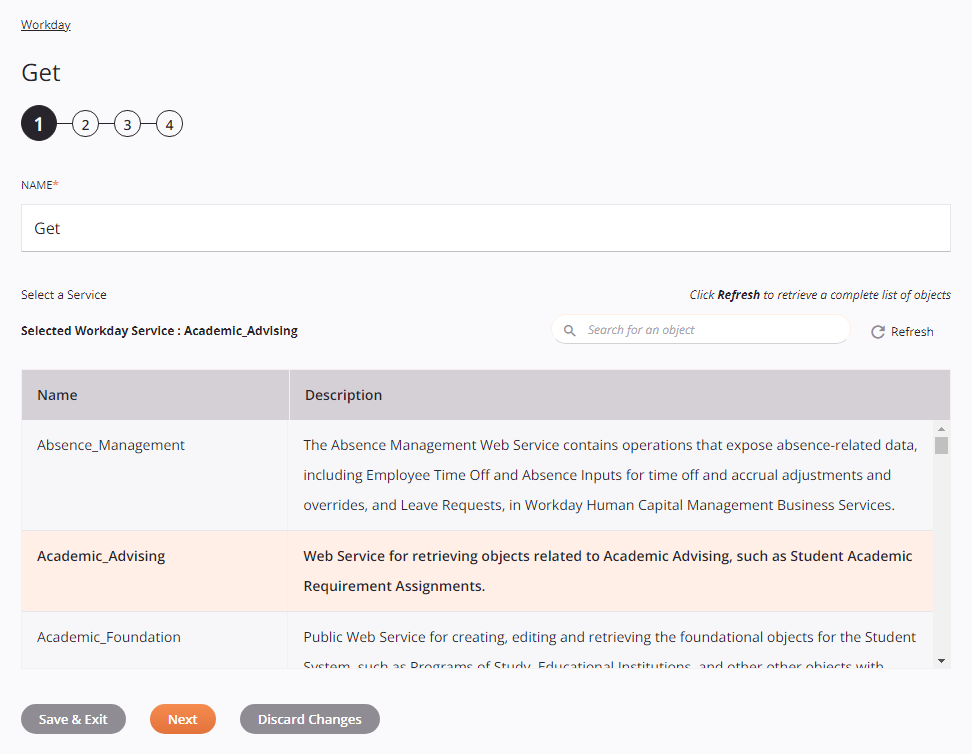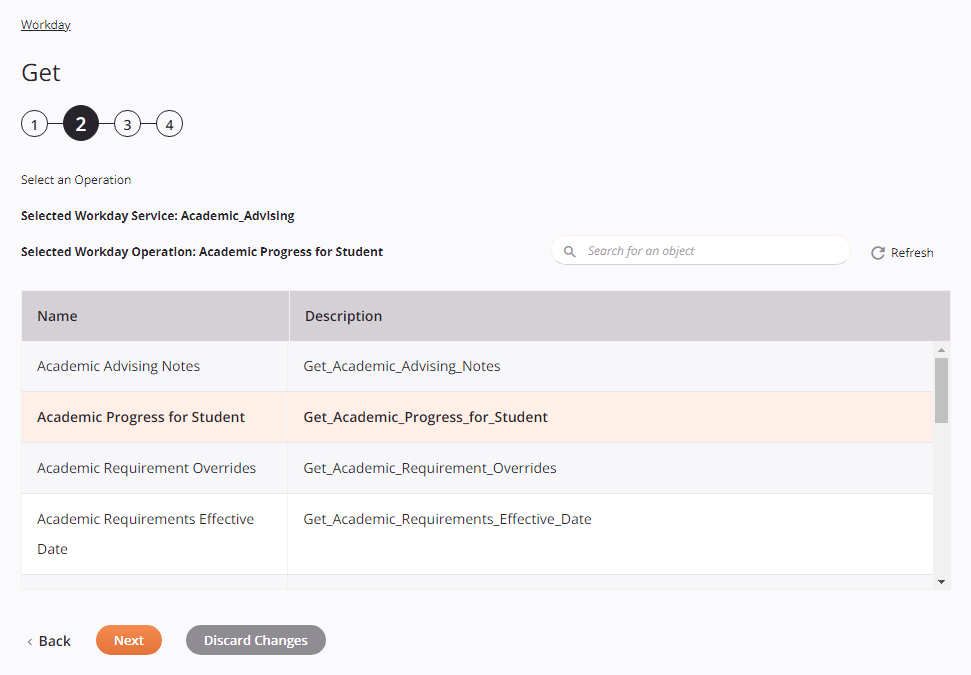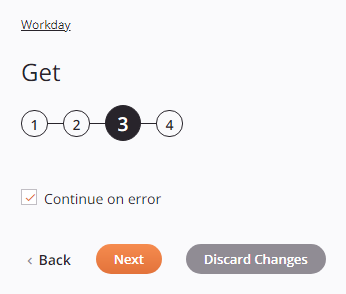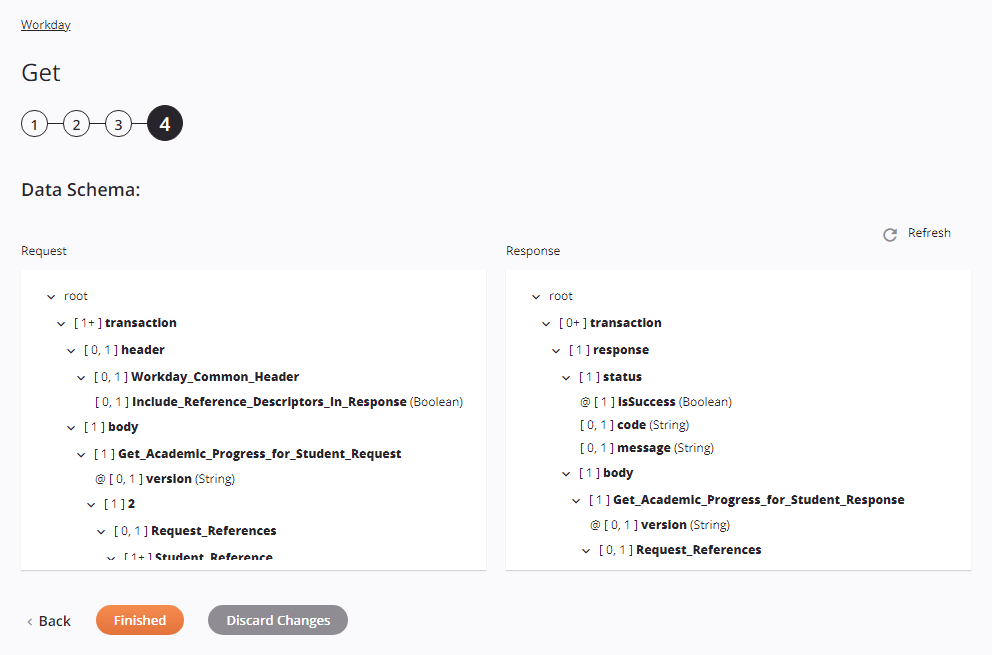Workday activity
Introduction
A Workday activity retrieves data from and/or sends data to a selected Workday web service and is used as a source or target in an operation. After configuring a Workday connection, you can configure as many Workday activities as you like for each Workday connection. Workday activities can be used both with standard and custom objects.
Create a Workday activity
An instance of an activity is created from a connection using an activity type.
To create an instance of an activity, drag the activity type to the design canvas or copy the activity type and paste it on the design canvas. For details, see Creating an activity instance in Component reuse.
An existing activity can be edited from these locations:
- The design canvas (see Component actions menu in Design canvas).
- The project pane's Components tab (see Component actions menu in Project pane Components tab).
Accessing menu actions
Menu actions for an activity are accessible from the project pane and the design canvas. For details, see Activity actions menu in Connector basics.
Configure a Workday activity
Follow these steps to configure a Workday activity:
- Step 1: Select a Workday web service
- Step 2: Select a Workday operation
- Step 3: Specify settings
- Step 4: Review data schema
In the example shown, a Workday get activity is being configured. Other Workday activities follow a similar pattern.
Step 1: Select a Workday web service

-
Name: Enter a name to use to identify the Workday activity. The name must be unique for each activity (of the same type) and must not contain forward slashes (
/) or colons (:). -
Select a Service: This section displays web services available in the Workday endpoint. When reopening an existing activity configuration, only the selected web service is displayed instead of reloading the entire web service list.
Caution
Workday WSDL versions v42.0 and v42.1 return errors when trying to fetch data for certain services. See limitations for more information.
If you need to use one of those services, choose a different Workday WSDL version in the Workday connection.
-
Selected Workday Service: After a web service is selected, it will be listed here.
-
Search: Enter any column's value into the search box to filter the list of web services. The search is not case-sensitive. If web services are already displayed within the table, the table results will be filtered in real time with each keystroke. To reload web services from the endpoint when searching, enter search criteria and then refresh, as described below.
-
Refresh: Click the refresh icon
 or the word Refresh to reload web services from the Workday endpoint. This may be useful if you have recently added web services to the Workday instance. This action refreshes all metadata used to build the table of web services displayed in the configuration.
or the word Refresh to reload web services from the Workday endpoint. This may be useful if you have recently added web services to the Workday instance. This action refreshes all metadata used to build the table of web services displayed in the configuration. -
Select a Service: Within the table, click anywhere on a row to select a web service. Only one web service can be selected. The information available for each web service is fetched from the Workday endpoint:
- Name: The web service name from Workday.
- Description: The web service description from Workday.
Tip
If the table does not populate with available web services, the Workday connection may not be successful. Ensure you are connected by reopening the connection and retesting the credentials.
-
-
Save & Exit: If enabled, click to save the configuration for this step and close the activity configuration.
-
Next: Click to temporarily store the configuration for this step and continue to the next step. The configuration will not be saved until you click the Finished button on the last step.
-
Discard Changes: After making changes, click Discard Changes to close the configuration without saving changes made to any step. A message will ask you to confirm that you want to discard changes.
Step 2: Select a Workday operation

-
Select an Operation: This section displays operations available for the selected web service in the Workday endpoint. When reopening an existing activity configuration, only the selected operation is displayed instead of reloading the entire operation list.
-
Selected Workday Service: The web service selected in the previous step will be listed here.
-
Selected Workday Operation: After an operation is selected, it will be listed here.
-
Search: Enter any column's value into the search box to filter the list of operations. The search is not case-sensitive. If operations are already displayed within the table, the table results will be filtered in real time with each keystroke. To reload operations from the endpoint when searching, enter search criteria and then refresh, as described below.
-
Refresh: Click the refresh icon
 or the word Refresh to reload operations from the Workday endpoint. This may be useful if you have recently added operations to the Workday instance. This action refreshes all metadata used to build the table of operations displayed in the configuration.
or the word Refresh to reload operations from the Workday endpoint. This may be useful if you have recently added operations to the Workday instance. This action refreshes all metadata used to build the table of operations displayed in the configuration. -
Select an Operation: Within the table, click anywhere on a row to select an operation. Only one operation can be selected. The information available for each operation is fetched from the Workday endpoint:
-
Name: The operation name from Workday.
-
Description: The operation description from Workday.
-
Tip
If the table does not populate with available operations, the Workday connection may not be successful. Ensure you are connected by reopening the connection and retesting the credentials.
-
-
Back: Click to temporarily store the configuration for this step and return to the previous step.
-
Next: Click to temporarily store the configuration for this step and continue to the next step. The configuration will not be saved until you click the Finished button on the last step.
-
Discard Changes: After making changes, click Discard Changes to close the configuration without saving changes made to any step. A message will ask you to confirm that you want to discard changes.
Step 3: Specify settings

-
Continue on Error: Select to continue the activity execution if an error is encountered for a dataset in a batch request. If any errors are encountered, they are written to the operation log.
-
Back: Click to temporarily store the configuration for this step and return to the previous step.
-
Next: Click to temporarily store the configuration for this step and continue to the next step. The configuration will not be saved until you click the Finished button on the last step.
-
Discard Changes: After making changes, click Discard Changes to close the configuration without saving changes made to any step. A message will ask you to confirm that you want to discard changes.
Step 4: Review data schema

-
Data Schema: The request and response data schemas from Workday will be displayed. If the operation uses a transformation, the data schemas will be displayed again later during the transformation mapping process, where you can map to target fields using source objects, scripts, variables, custom values, and more.
The Workday connector uses the Workday web services (wws) API versions 32.0 through 43.0, depending on the version selected in a Workday connection. Refer to the API documentation for information on the schema fields.
-
Refresh: Click the refresh icon
 or the word Refresh to regenerate schemas from the endpoint. This action also regenerates the schema in other locations throughout the project where the same schema is referenced, such as in an adjacent transformation.
or the word Refresh to regenerate schemas from the endpoint. This action also regenerates the schema in other locations throughout the project where the same schema is referenced, such as in an adjacent transformation. -
Back: Click to temporarily store the configuration for this step and return to the previous step.
-
Finished: Click to save the configuration for all steps and close the activity configuration.
-
Discard Changes: After making changes, click Discard Changes to close the configuration without saving changes made to any step. A message will ask you to confirm that you want to discard changes.
Next steps
After configuring a Workday activity, complete the configuration of the operation by adding and configuring other activities, transformations, or scripts as operation steps. You can also configure an operation's operation settings, which include the ability to chain operations together that are in the same or different workflows.
Workday activities that are used as a source can be used with these operation patterns:
- Transformation pattern
- Two-target archive pattern (as the first source only)
- Two-target HTTP archive pattern (as the first source only)
- Two-transformation pattern (as the first or second source)
Other patterns are not valid using Workday activities that are used as a source.
Workday activities that are used as a target can be used with these operation patterns:
- Transformation pattern
- Two-transformation pattern (as the first or second target)
Other patterns are not valid using Workday activities that are used as a target.
See the validation patterns on the Operation validity page.
To use the activity with scripting functions, write the data to a temporary location and then use that temporary location in the scripting function.
Operations that use Workday activities can also have operation actions configured to trigger upon a SOAP fault — an error resulting from an incorrect message format, header processing, or incompatibility. Operation actions can be configured to run an operation or send an email after a SOAP fault occurs. For instructions on triggering an action upon SOAP fault, refer to Operation actions.
When ready, deploy and run the operation and validate behavior by checking the operation logs.